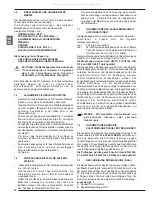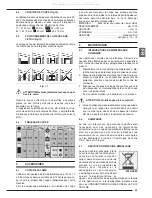
8
EN
1.4
RECOMMENDED AND NOT
RECOMMENDED USAGE
This belt sawing machine was designed and constructed
according to the most advanced technologies and may be
used for all cutting requirements for metals commonly
used in industry and artisanship.
It can cut:
- COMMON STEELS (FE 37...)
- SPECIAL STEELS (C 40, 18NiCrMo5...)
- ALUMINIUM AND ITS ALLOYS
- BRASS
- BRONZE
- STEEL TUBING (FE 35, FE 52...)
- PROFILED SECTIONS IN SHEET METAL AND
ALUMINIUM
It is not suitable for cutting:
- WOOD AND SIMILAR MATERIALS
- BONE AND SIMILAR MATERIALS
ATTENTION: The band saw has been developed
and manufactured to cut in dry condition; the
use of any cooler by lubricating oil makes the
machine unusable.
Consult the relative sections for cutting capacities, the
speeds to use and the type of tools for use according to
the material to be cut and its section. (See list of contents).
1.5
STANDARD SAFETY PROCEDURS
- Do not use the machine in very damp places or in the
presence of inflammable liquids or gases.
- Do not use it in the open air when general weather and
environmental conditions are unfavourable (eg.
explosive atmospheres, during a storm or rain).
- Wear suitable clothes, without wide sleeves or articles
such as scarves, chains and bracelets which could
get caught in the moving parts.
- Always use personal protection devices: protective
goggles as recommended by safety standards, gloves
of the right size, headphones or earplugs, and hairnets
if necessary.
- Use the tools recommended in this manual if you want
to achieve the best performance from your sawing
machine.
- Any power cable extensions must be type approved
and comply with safety standards.
- Avoid using the machine if your psycho-physical
condition are precarious or upset.
1.6
SAFETY PROCEDURS FOR FURTHER RISK
- Always keep processing residues away from the cutting
area.
- Always use the clamp. The parts to be cut must always
be held firmly in the clamp.
- Always keep hands away from the working areas while
the machine is moving: before loading or unloading the
part, release the run button on the hand grip.
- Do not force the machine unnecessarily : excessive
cutting pressure could cause rapid wear to the blade
and negatively influence the performance of the
machine in terms of finishes and cutting precision.
1.7
INFORMATION REGARDING NOISE AND
VIBRATIONS
In normal conditions of use as described in this manual,
this belt sawing machine determines an equivalent level of
acoustic pressure:
Leq =
82 dB(A) when operating unloaded;
Leq =
84,3 dB(A) during processing (eg. cutting of a
steel tube D.80 mm thickness 5 mm), at cutting
speed of 80 m/min., with a weighted operating
cycle of 1 minute.
The measurements are taken in accordance with
standards UNI7712, ISO3740, ISO 3746 and EEC 98/37.
The emission levels indicated are not necessarily safety
levels. Although there is a relationship between the
emissions and exposure levels, the values shown cannot
be used for establishing the need for further precautions.
There are other factors which influence the exposure levels
of operators, such as the features of the work place,
presence of other sources of noise, number of machines
running, etc.
The exposure levels may also vary between countries.
This information is necessary for the user for better
evaluation of the risks and hazards deriving from noise.
NOTE : Personal hearing protection should be
used, such as headphones or earplugs.
1.8
INFORMATION ABOUT THE
ELECTROMAGNETIC COMPATIBILITY
The European regulations on safety and, in particular, the
EEC Directive
2004/108/CE
contemplate that all the
equipment be equipped with shielding devices against radio
interferences both from and towards the outside.
This machine is equipped with filters both on the motor and
on the power supply through which the machine is safe and
in compliance with above regulations.
The frequency root mean RMS weighed for hand-arm
acceleration does not exceed 2.5m/s².
Tests were carried out according to 61000-6-1, EN 61000-
6-3, EN 55014-1, EN 55014-2 regulations.
1.9
DESCRIPTION OF THE MACHINE (Fig.1)
The belt sawing machine consists of two basic parts: the
machine body
5
complete with motor and drive
7
which is
integrated into lower part, consisting of the clamp
11
and
the base
13
, by means of the swivel support
9
.
Here is a list of the main parts with the number indicating
it in the drawing.
Legend Fig. 1
1.
Command grip
2.
Blade tension handwheel
4.
Sliding blade guide
5.
Machine body
6.
Blade
7.
Motor
8.
Control box
9.
Bar stop
10.
Clamp (vice)
11.
Morsa
12.
Clamp drive
13.
Base
All manuals and user guides at all-guides.com



























